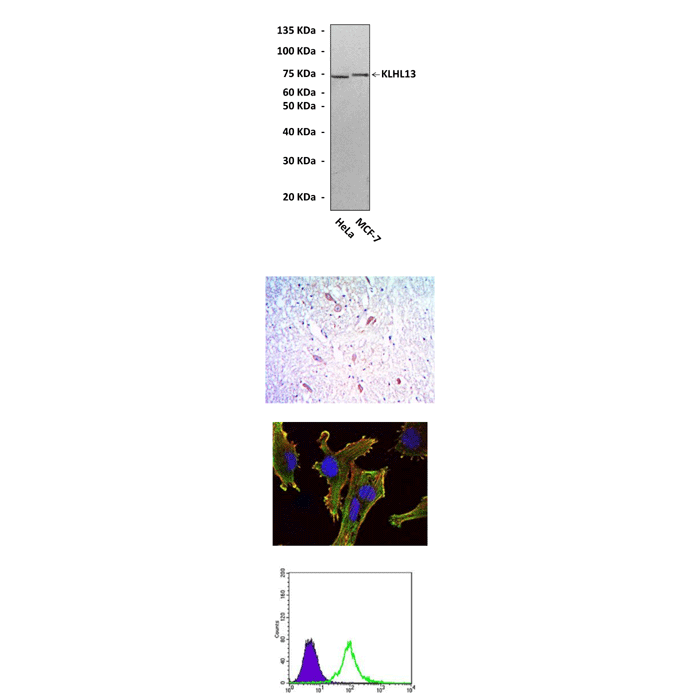Anti-KLHL13: Mouse KLHL13 Antibody |
 |
BACKGROUND KLHL13 belongs to the kelch repeat domain containing superfamily of proteins. It is also known as BKLHD2 (BTB and kelch domain-containing protein 2).1 KLHL13 contains six Kelch repeats and one BTB/POZ domain. It functions as an adaptor protein that complexes with Cullin 3 and other proteins to form the Cullin 3-based E3 ubiquitin-protein ligase complex. This complex is necessary for proper chromosome segregation and completion of cytokinesis.2 KLHL13 is expressed predominantly in brain. It has been shown that KLHL13 and other BTB protein KLHL9 form a complex with Cul3, which is required for ubiquitination of the mitotic kinase Aurora B. Aurora B is a member of the chromosomal passenger complex (CPC) together with the inner centromere protein (INCENP), Borealin/Dasra B, and survivin. Aurora B kinase activity depends on association with its coactivator INCENP and on autophosphorylation of Thr232. Importantly, the CPC is also regulated at the level of subcellular localization. In early mitosis, it localizes to centromeres, where it regulates kinetochore assembly and function and thereby plays essential roles in chromosome alignment, segregation, and the spindle assembly checkpoint. After anaphase onset, the CPC accumulates at the spindle midzone and the midbody, where it ensures completion of cytokinesis. Although the mechanisms of this dynamic localization are poorly understood, recent evidence suggests a critical role for the ubiquitination of CPC components. Ubiquitination of survivin may trigger CPC binding to centromeres, whereas Cul3–KLHL9–KLHL13 E3 ligase–dependent ubiquitination of Aurora B may regulate recruitment of the CPC to the spindle midzone. Indeed, KLHL9 and KLHL13 bind Aurora B in vivo and in vitro, and Aurora B is ubiquitinated in a KLHL9- and KLHL13-dependent manner. In Xenopus laevis egg extracts, the AAA-ATPase p97 in complex with the cofactors Ufd1-Npl4 binds ubiquitinated Aurora B and may extract it from mitotic chromosomes. Therefore, it is possible that Cul3–KLHL9–KLHL13 ubiquitinates Aurora B, thereby promoting translocation of the CPC to the spindle midzone. KLHL21 and KLHL22 are other two novel regulators of mitosis. Unlike KLHL22, KLHL21 regulates CPC translocation at the onset of anaphase and is required for completion of cytokinesis. KLHL21 directly interacts with Aurora B and mediates ubiquitination of Aurora B in vitro. In contrast to KLHL9 and KLHL13, KLHL21 localizes to midzone microtubules during anaphase and targets Cul3 and Aurora B to this region. Thus, differential localization of distinct Cul3 complexes with KLHL9, KLHL13, and KLHL21 may target different pools of Aurora B during mitosis. KLHL21 may function as a specificity factor to ubiquitinate Aurora B on the midzone, whereas KLHL9 and KLHL13 may mainly target the cytoplasmic pool of Aurora B at this stage.3
REFERENCES
1. Seng, S. et al: Mol. Cell. Biol. 26:8371-84, 2006
2. Sumara, I. et al: Trends Cell Biol. 18:84-94, 2008
3. Maerki, S. et al: J. Cell Biol. 187:791-800, 2009
2. Sumara, I. et al: Trends Cell Biol. 18:84-94, 2008
3. Maerki, S. et al: J. Cell Biol. 187:791-800, 2009
Products are for research use only. They are not intended for human, animal, or diagnostic applications.
Параметры
Cat.No.: | CP10338 |
Antigen: | Raised against recombinant human KLHL13 fragments expressed in E. coli. |
Isotype: | Mouse IgG1 |
Species & predicted species cross- reactivity ( ): | Human, Mouse, Rat |
Applications & Suggested starting dilutions:* | WB 1:1000 IP n/d IHC 1:50 - 1:200 ICC 1:50 - 1:200 FACS 1:50 - 1:200 |
Predicted Molecular Weight of protein: | 74 kDa |
Specificity/Sensitivity: | Detects endogenous KLHL13 proteins without cross-reactivity with other family members. |
Storage: | Store at -20°C, 4°C for frequent use. Avoid repeated freeze-thaw cycles. |
*Optimal working dilutions must be determined by end user.
Документы
Информация представлена исключительно в ознакомительных целях и ни при каких условиях не является публичной офертой








